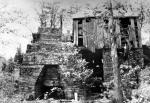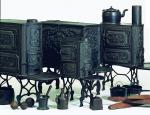![header=[Marker Text] body=[Forge built 1744 by Wm. Bird; furnace built 1770 by his son Mark. Furnace and other remains of an ironmaking community of the era, administered by National Park Service, are about 7.5 miles away. ] sign](http://explorepahistory.com/kora/files/1/10/1-A-161-139-ExplorePAHistory-a0a8o2-a_450.gif)
Mouse over for marker text
Name:
Hopewell Village
Region:
Hershey/Gettysburg/Dutch Country Region
County:
Berks
Dedication Date:
August 8, 1948
Behind the Marker
During the colonial period, iron was one of Pennsylvania's principal commercial products and a major export in the trans-Atlantic trade. The colony enjoyed a natural abundance of iron ore, limestone, and hardwood trees, all of which were necessary raw materials for the industry. By the early 1700s, American colonists had also imported or developed on their own most of the techniques needed to make both pig or bar iron and finished iron products. Iron-making was a rural industry, for it was cheaper and easier to transport finished iron to towns or ports than to bring together the raw materials in those places, and blast furnaces, which operated around the clock, consumed spectacular quantities of wood. Iron "plantations" required huge forest reserves of up to 10,000 acres to keep production going.
At the same time rural iron plantations, especially those with multiple forges and furnaces, were among the most complex technological enterprises in the eighteenth-century world. While urban merchants who seldom visited the sites usually provided capital, the plantations were managed by special "iron masters," who often rose from the ranks. Slaves and journeymen specialists, whose talents were in great demand, provided skilled labor.
By the 1750s, a belt of operations running from the lower Hudson Valley, across northern New Jersey, through central Pennsylvania, into western Maryland and northern Virginia, produced more iron than all of Great Britain. Nor did these prosperous enterprises escape the attention of Parliament, which passed an Iron Act in 1750 to secure a supply of iron for Great Britain and to raise revenue for the English government. While the Iron Act permitted the production of bar and pig iron, it also required that the iron be shipped to Britain for manufacture into consumer products. The measure, however, proved to be impossible to enforce. It was difficult enough for the Crown to get inspectors to the wharves and warehouses of Boston, New York, and Philadelphia after 1763, but impossible to police the interior. The ease with which iron producers evaded imperial regulation illustrates why Pennsylvanians found it difficult to sympathize with the economic hardships that New England's merchants were experiencing and, thus, hesitated to join in the early stages of the movement for independence.
One of the finest examples of a rural, eastern Pennsylvania iron plantation is Hopewell Forge, built during the 1740s by William Bird, in the upper Schuylkill River Valley of Berks County. The forge used bar iron made at other nearby furnaces. When Bird died in 1761, he left his son Mark with a thriving business of two forges and more than 3,000 acres of land. Mark Bird used his energy and connections to expand the operations in the first decade of the imperial crisis. By 1771 he owned more than 8,000 acres of land, and had built a furnace on French Creek, near the boundary between Berks and Chester Counties. The new furnace enabled him to supply raw iron to his own forge operations, rather than rely on outside operators.
Bird also owned at least eighteen African slaves, making him one of the larger slave owners in Pennsylvania. The slaves worked at his forges and are said to have dug Hopewell's original headrace, which turned the waterwheel that supplied air to fire the furnace. Although slavery in Berks County declined after Pennsylvania passed a gradual abolition act in 1780, blacks continued to work at Hopewell Furnace as paid employees. Some black laborers lived in the nearby forest and served as conductors on the Underground Railroad. Many former slaves worked at Hopewell Furnace as woodcutters, colliers, and teamsters.
As the resistance to British rule intensified in the late 1760s and early 1770s, Bird became a strong advocate of the principles of liberty. A member of Pennsylvania's Committee of Correspondence in 1775, he was elected to its Provincial Conference in 1776, an ad hoc body that oversaw the transition from the discredited Assembly of the colony and the new constitutional government of the state. After the colonies declared independence in July, 1776, Bird's devotion to the patriot cause - and probably his connection to James Wilson, his brother-in-law and a leading member of the Continental Congress - won him contracts to supply Continental forces with cannons and munitions. Bird also served as a Deputy Quartermaster for the state government, and shipped foodstuffs and other supplies down the Schuylkill to the army during the Valley Forge winter.
James Wilson, his brother-in-law and a leading member of the Continental Congress - won him contracts to supply Continental forces with cannons and munitions. Bird also served as a Deputy Quartermaster for the state government, and shipped foodstuffs and other supplies down the Schuylkill to the army during the Valley Forge winter.
Bird did not, however, profit from the many business opportunities created by the war. Overextended during the long commercial depression that followed the war in the 1780s, he had difficulty getting paid by a Continental government that was itself virtually bankrupt. In 1788, Bird and Wilson fled to North Carolina to avoid debtor's prison. He died there in 1816, still embittered by his fate, and in some ways as much a victim of the turbulence of the Revolutionary War as any Loyalist refugee.
Hopewell Furnace, on the other hand, prospered during the market revolution of the early 1800s. Concentrating on castings, Hopewell's charcoal-fired and water-powered furnaces provided stoves, pots, kettles, and other iron products to east-coast markets. In the mid-1800s, technological innovations in iron and steel production rendered Hopewell's coal-fired and water powered furnaces obsolete. Hopewell Furnace closed in 1883 but was reborn as a national historical site in the 1930s.
At the same time rural iron plantations, especially those with multiple forges and furnaces, were among the most complex technological enterprises in the eighteenth-century world. While urban merchants who seldom visited the sites usually provided capital, the plantations were managed by special "iron masters," who often rose from the ranks. Slaves and journeymen specialists, whose talents were in great demand, provided skilled labor.
By the 1750s, a belt of operations running from the lower Hudson Valley, across northern New Jersey, through central Pennsylvania, into western Maryland and northern Virginia, produced more iron than all of Great Britain. Nor did these prosperous enterprises escape the attention of Parliament, which passed an Iron Act in 1750 to secure a supply of iron for Great Britain and to raise revenue for the English government. While the Iron Act permitted the production of bar and pig iron, it also required that the iron be shipped to Britain for manufacture into consumer products. The measure, however, proved to be impossible to enforce. It was difficult enough for the Crown to get inspectors to the wharves and warehouses of Boston, New York, and Philadelphia after 1763, but impossible to police the interior. The ease with which iron producers evaded imperial regulation illustrates why Pennsylvanians found it difficult to sympathize with the economic hardships that New England's merchants were experiencing and, thus, hesitated to join in the early stages of the movement for independence.
One of the finest examples of a rural, eastern Pennsylvania iron plantation is Hopewell Forge, built during the 1740s by William Bird, in the upper Schuylkill River Valley of Berks County. The forge used bar iron made at other nearby furnaces. When Bird died in 1761, he left his son Mark with a thriving business of two forges and more than 3,000 acres of land. Mark Bird used his energy and connections to expand the operations in the first decade of the imperial crisis. By 1771 he owned more than 8,000 acres of land, and had built a furnace on French Creek, near the boundary between Berks and Chester Counties. The new furnace enabled him to supply raw iron to his own forge operations, rather than rely on outside operators.
Bird also owned at least eighteen African slaves, making him one of the larger slave owners in Pennsylvania. The slaves worked at his forges and are said to have dug Hopewell's original headrace, which turned the waterwheel that supplied air to fire the furnace. Although slavery in Berks County declined after Pennsylvania passed a gradual abolition act in 1780, blacks continued to work at Hopewell Furnace as paid employees. Some black laborers lived in the nearby forest and served as conductors on the Underground Railroad. Many former slaves worked at Hopewell Furnace as woodcutters, colliers, and teamsters.
As the resistance to British rule intensified in the late 1760s and early 1770s, Bird became a strong advocate of the principles of liberty. A member of Pennsylvania's Committee of Correspondence in 1775, he was elected to its Provincial Conference in 1776, an ad hoc body that oversaw the transition from the discredited Assembly of the colony and the new constitutional government of the state. After the colonies declared independence in July, 1776, Bird's devotion to the patriot cause - and probably his connection to
Bird did not, however, profit from the many business opportunities created by the war. Overextended during the long commercial depression that followed the war in the 1780s, he had difficulty getting paid by a Continental government that was itself virtually bankrupt. In 1788, Bird and Wilson fled to North Carolina to avoid debtor's prison. He died there in 1816, still embittered by his fate, and in some ways as much a victim of the turbulence of the Revolutionary War as any Loyalist refugee.
Hopewell Furnace, on the other hand, prospered during the market revolution of the early 1800s. Concentrating on castings, Hopewell's charcoal-fired and water-powered furnaces provided stoves, pots, kettles, and other iron products to east-coast markets. In the mid-1800s, technological innovations in iron and steel production rendered Hopewell's coal-fired and water powered furnaces obsolete. Hopewell Furnace closed in 1883 but was reborn as a national historical site in the 1930s.
Beyond the Marker







